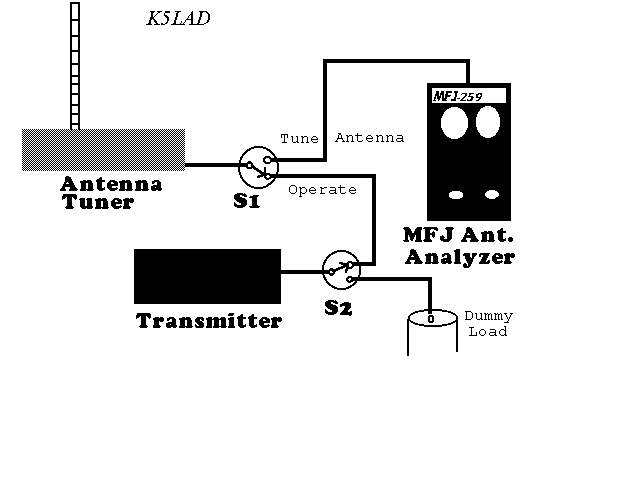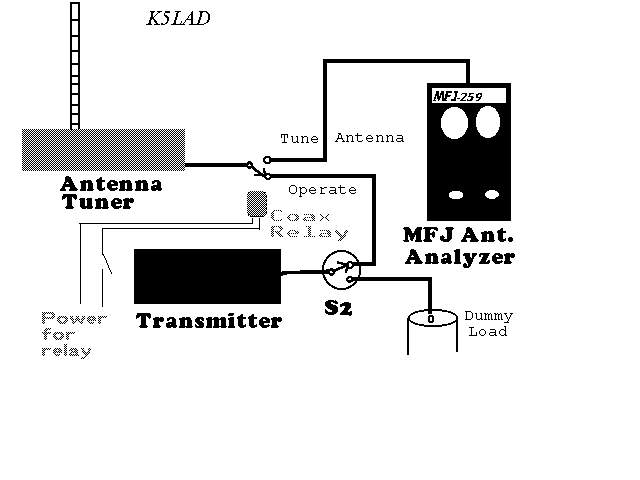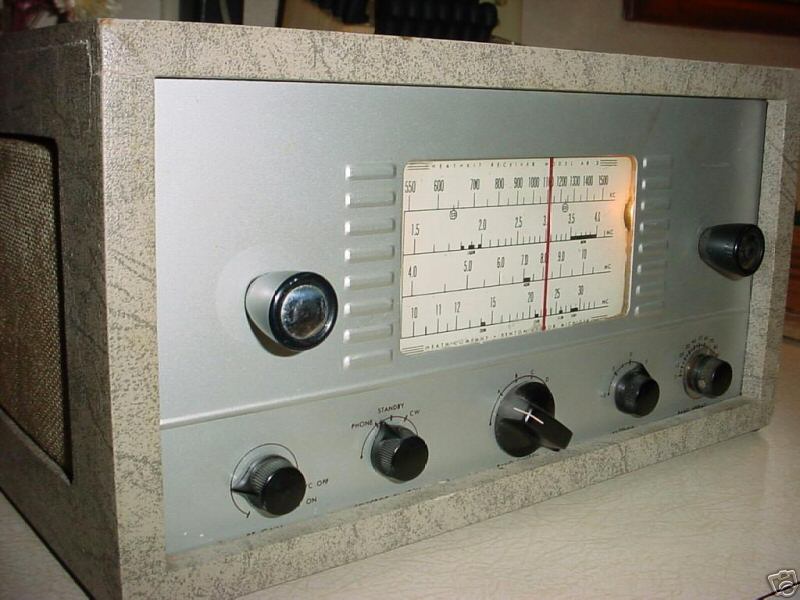K5LAD's Assorted Ham Stuff
2. The funniest thing that ever happened to me on the air....
4. QSL Cards through the years
8. "I can’t work 80 meters, I don’t have a good 80 meter antenna"
9. Modifications to the Dentron Super Tuner
10. Good Documentation for the Dentron MT-3000A antenna tuner
11. Modifying the MT-3000A tuner for additional features
12. Good Documentation for the Dentron AT-3K antenna tuner
13. K5LAD's Awards
14. A Simplified View of Roofing Filters
***********************************************
What is more irritating that trying to talk to another ham, only to have things spoiled by a tuner-upper on your frequency? This is the system I use to make sure I don't do that to someone else.
To make sure I don't cause problems to others when I tune up, I use the system below. By placing the switch (S1) in the "Tune Antenna" position, the MFJ Antenna Analyzer is connected through the Antenna Tuner to the antenna. I set the Analyzer on the frequency I plan to operate, or somewhere close around there, and adjust the Tuner until I have the lowest SWR. Since the Analyzer is calibrated to 50 ohms, my coax from the Tuner, when adjusted, is pretty close to 50 ohms
I also use switch S2 which allows me to tune up into my Dummy Load, which is 50 ohms. Using the Dummy Load keeps my signal pretty much within a close area from my station.
At this point, I only need to turn both switches back to their home positions (both S1 and S2 to Operate) and I have the transmitter matched to the input of the Tuner and the Tuner matched to the Antenna.

Actually, my system goes one step further than the picture shown above. Instead of a manual switch at S1, I use a coax relay from the "good ole' days." I have a convenient switch directly in front of me to press and it performs the switching task shown at switch S1. I could also use a coax relay to replace S2 but did not have a spare when I built up the circuit. It looks something like this:

Purists and some older timers than me (I'm from the mid-50s era) will tell you things like, "well I once worked a guy on CW who was 18 miles away while I was using my Dummy Load!" and "that MFJ Analyzer has an oscillator which can also be heard while you are tuning the Tuner...." and they are both correct. I have heard Dummy Loaded signals several miles away too. I also once was surprised that my MFJ 259 was able to key a local repeater while tuning carefully around the input frequency when I had an antenna attached. It does emit a signal, although it is quite small.
The plain truth is, however, that if you use a system like this you sure won't be QRMing an existing QSO.
==========================================================================================================
The Funniest Thing That Ever Happened to Me On the Air The following addition was originally placed in my "Profile" section in eHam.com. They had asked those who filled out the form to tell "the funniest thing that ever happened to me on the air was..........". I told this story, which is all true, and I have received several email from those who saw it, telling me that they enjoyed reading it. I figured that I probably should port it over to my web pages too. So here it is......................
|
====================================================================================
If you were to ask most hams about their favorite antenna, you will probably hear about a wonderful; multi-element yagi that allowed them to talk with hams all over the world. Or perhaps they will lean back in their easy chair and tell about a dipole which they placed in a big tree when they were a new ham and the excitement they received when they first heard their call coming back to them after calling CQ for three hours.
Some might tell you about some contraption they built which followed absolutely no rules of physics, electronics, or anything else. What a thrill they received when someone actually heard them and returned their call.
All of those antenna hold a special place in the heart of a ham but I wanted to tell you about my favorite antenna. It wasn't fancy, it certainly wasn't expensive to build, and it didn't even work particularly well.
The time was in the early years after I had gotten married, had graduated from college and had even gotten a job. As a struggling new school teacher, we sure didn't have much money to spend on amateur radio but the excitement of the hobby was intense. I had always wanted to try operating on 144 MHz. and, thanks to my participation in Army MARS, I had a set of military units which could be converted for 2 meter operation.
The ARC-3 receiver received a homebrew VFO to replace the crystals and allowed me to hear signals between 100 - 156 MHz...... come to think of it, I wasn't able to listen to anything on "mega-hertz." I was listening on "mega-cycles." The ARC-3 transmitter got a nice big power supply built up from MARS shipments and I not only hooked up a Heath VF-1 VFO to it but I was able to actually convert it to go from AM to FM and back with just the flip of a switch.
But I needed an antenna. Buy one? No way. Build one........... hmmm...... I tried to find aluminum pieces but had no success. I couldn't even find any old TV antennas to tear apart and reuse. The year was 1964-65 and I still needed a 2 meter antenna.
Finally I was able to build one from some junk parts I was able to locate. This was my favorite. I tried to find just one piece of aluminum to use as the boom but had no luck. I even tried to find an old broom or mop handle but couldn't even find that. What I did find was a piece of bamboo which someone had abandoned. It wasn't particularly strong, it wasn't even particularly straight but it would work. I found some heavy steel clothesline wire to use for elements. Back then, there were more clotheslines and fewer dryers than there are now. The wire, which was probably about #4 gauge, worked fine as elements.
It was fairly easy to find some old 300 ohm twinlead to feed the folded dipole driven element. Down in the shack, I had some sort of a balun to convert to the short piece of coax which someone had given me. I can't remember what I found to use as a mast but I remember that I did use the "armstrong method" of rotation.
My favorite antenna was not very high, it didn't allow me to work into lots of states and most 2 meter veterans would probably have laughed at it and said I was crazy for calling it my favorite. This antenna was not my favorite because of it's appearance as that was terrible. It was not my favorite because it worked so much better that any other as it really didn't. My reason for calling it my favorite antenna was taken from its name which came from the building materials used to construct it. After all, who among you wouldn't enjoy telling your contacts that you were using a "Bamboo Boom Beam?" Say that aloud................ isn't that fun? ----- Jim/K5LAD
=================================================================
Early Ham Memories
1. My First Receiver
I'm reminded of my experience with the AR-3 which was my first receiver and also the first kit I'd ever built. The year was 1957 and I was a new novice and anxious to get on the air and at least listen to some hams.
First time kit-builders sometimes are guilty of skimming over the instructions in order to get to the main project and see it work. I didn't know about trimming the leads on components so all mine were full lead length, just like the day they were manufactured.
I quickly hurried past any cautions and soldered it all together. Amazingly, it lit up and even would receive something, although now I don't remember what I heard. Perhaps it was only noise from the speaker, but it was something. My very first kit and it worked. I was thrilled.
The book suggested that I take it to a ham friend to do the alignment and I knew just the guy, Tommy - W5CFF. He was a member of our small amateur radio club and also worked for the telephone company. Best of all, he had lots of really good test equipment and offered to do the alignment for me. I remember the anticipation as I watch him with my wonderful receiver on his bench as he set about to line it all up. The frown on his face worried me a bit but he continued to work on it.
Finally, he put the tools down and said, "Jim, I can't get it to hold still long enough for me to align." I asked him why and he told me long lead lengths caused it to be unstable. I didn't know a lot about radios then but that didn't sound good.
I said, "What can I do to fix it?" He said, "Well, if it were mine, I'd unsolder everything and start again." He carefully showed me how to use minimum lengths on the components and even showed me how he lined them up so they were going the same direction. He told me that didn't make it work any better but just looked nicer when others viewed my handi-work.
I've never forgotten his excellent advice. I took my spidery-looking AR-3 back home and removed all the soldered-in pieces. I then took my time and rebuilt my receiver kit, but this time, like it was supposed to be. Not surprisingly, it took me quite a bit longer to build it the second time but it sounded, and looked, so much better.
I took it back to Tommy to realign and this time it was solid as a rock....... at least as solid as an AR-3 could be. I used it for several years and it was a great receiver. I would love to have it back now since it still has a special place in my early ham years memory.----------- Added August 4, 2005
========================================================================Page visited 1730 times Last updated 11/06/2012 16:59:21 PM
